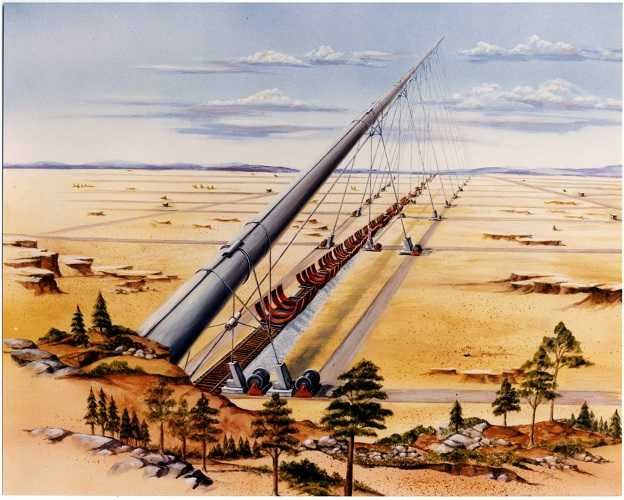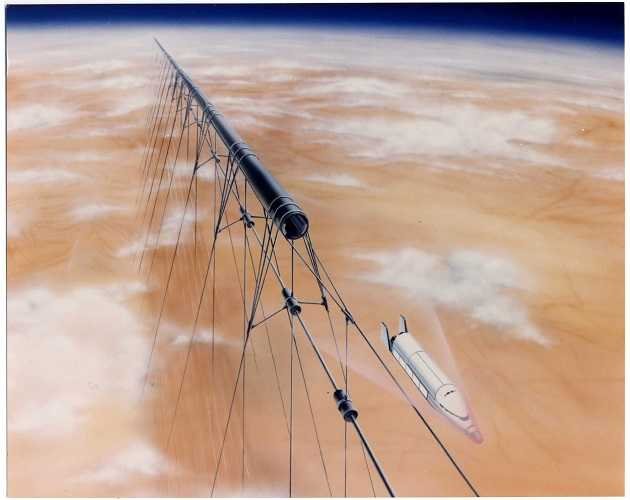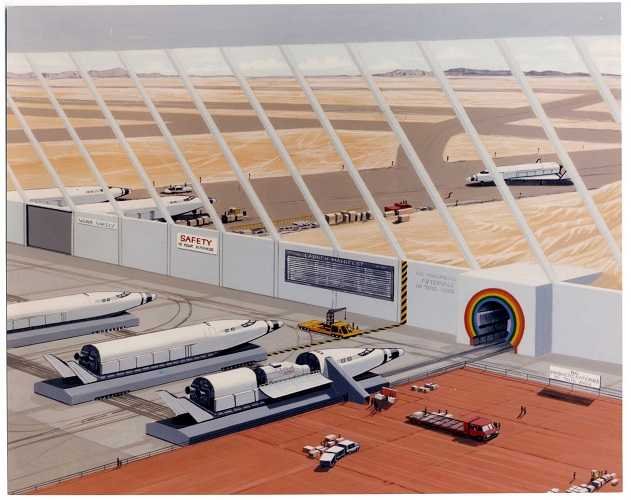Skip to comments.
Will We Ever Stop Using Rockets to Get to Space?
space,com ^
| August 19, 2018 08:01am ET
| By Ross Pomeroy, RealClearScience |
Posted on 08/19/2018 11:08:03 PM PDT by BenLurkin
One of the most futuristic and far-fetched is the space elevator....simple enough on paper – extend a 22,000 mile set of cables from a space station in geostationary orbit to a corresponding structure somewhere at Earth's equator.
... The problem...is that the cable system must be constructed from a material far stronger than anything known. Carbon nanotubes have been hypothesized to fill this niche, but they aren't ready yet.
…
Another potential rocket replacement is StarTram….
Magnetically-levitated spacecraft will be propelled inside a curved tube aimed skyward. All air will be evacuated from the tube in order to eliminate drag. Craft will exit the lengthy tube at a speed of 8.8 kilometers per second in order to escape Earth's atmosphere. A generation-1 StarTram design intended to launch cargo vessels will feature a 81-mile tube built up the side of a mountain to reach a launch altitude of 12,000 to 20,000 feet.
The beautiful thing about StarTram is that it's surprisingly feasible. All the required tech exists today; it just needs to be scaled up big time. That makes building StarTram a matter of time and money rather than a flight of fancy. Is StarTram's $20 to $50 billion price tag worth it? Possibly. It could reduce cargo costs to space to just $20 to $50 per kilogram, potentially unlocking trillions of dollars worth of new industries.
Another idea, courtesy of JP Aerospace, eschews fiery rockets for giant airships that gently ascend all the way to space. A massive V-shaped "Ascender" aircraft would ferry cargo and passengers to the permanently floating "Dark Sky Station" at 140,000 feet. From there, an "Orbital Ascender" airship powered by ion engines would complete the journey to space. JP Aerospace's original funding came from the Air Force, and they're still highlighting progress on their blog.
(Excerpt) Read more at space.com ...
TOPICS: Science
KEYWORDS: balloonlaunch; elonmusk; falcon9; falconheavy; nasa; spaceelevator; spacex; startram
Navigation: use the links below to view more comments.
first previous 1-20, 21-39 last
To: BenLurkin
21
posted on
08/20/2018 3:48:08 AM PDT
by
Drumbo
("Democracy can withstand anything except democrats." - Robert A. Heinlein)
To: BenLurkin
How about we build the wall first!?
22
posted on
08/20/2018 4:07:07 AM PDT
by
FrankR
(IF it wasn't for the "F-word", and it's deritiives, the left would have no message at all.)
To: BenLurkin
The tube idea is great but not for humans (at least not without a seriouslength of tube). To achieve that speed without imparting too much g forces would require a speed up section of tube like 60-100 miles long. Then once exiting the tube at 18,000 feet at 19,000 mph(their speed number) you would hit a thinning but still substantially cross section of atmosphere to require some serious heat shielding.
It could work. But would require quite a super long lead.
The tube idea as a form of transportation across continents is compelling. Take the same maglev vacuum tube and lay it from NY to LA. Would make jet travel seem very slow.
23
posted on
08/20/2018 4:17:45 AM PDT
by
Vaquero
(Don't pick a fight with an old guy. If he is too old to fight, he'll just kill you.)
To: SunkenCiv
The space elevator has always had fundamental physics challenges and always will.
The trans-linear vector theory is where the answer(s) lie. /s
24
posted on
08/20/2018 4:24:35 AM PDT
by
mad_as_he$$
(If I knew when I was going to need my gun, I wouldn't need my gun.)
To: BenLurkin
“To the Moon, Alice! To the Moon!”.......
25
posted on
08/20/2018 4:28:43 AM PDT
by
trebb
(So many "experts" with so little experience in what they preach....even here...)
To: BenLurkin
A tube would be built and held in the air using magnetically suspended superconducting cables and high strength structural tethers. To achieve launch velocity the 1,000 mile long tube would be a vacuum and would launch the spacecraft out of the tube at an altitude of 12 miles, the speed it will be going at is 20,000mph - enough to carry it into a low orbit. To stop air from entering the vacuum tube magneto hydrodynamic pumps (MHD) would continuously expel gasses, maintaining a near-vacuum at all times. Basically a mass driver launch into space.
26
posted on
08/20/2018 4:31:43 AM PDT
by
COBOL2Java
(Marxism: Trendy theory, wrong species)
To: Theophilus
an 81 mile space tube attached to the Andes would have to contend with earthquakes
To: a fool in paradise
28
posted on
08/20/2018 4:37:38 AM PDT
by
Theophilus
(Repent)
To: BenLurkin
Musk and his Tesla scam could easily handle this. Bet he could do it for under $2-3 trillion of US Taxpayer’s monies. </sarc>
29
posted on
08/20/2018 5:04:40 AM PDT
by
Carriage Hill
(Life is simpler when you plow around the stump.)
To: BenLurkin
Another stupid idea filling the pages of “science” magazines.
30
posted on
08/20/2018 5:21:51 AM PDT
by
I want the USA back
(Media deliberately and intentionally chooses to lie, with full awareness and knowledge.)
To: JustaTech
“Will We Ever Stop Using Rockets to Get to Space?
Yes.”
Haven’t we already done that? As I understand it, we use Russian rockets to get us into space.
31
posted on
08/20/2018 5:39:47 AM PDT
by
EQAndyBuzz
(Proud member of the DWN party. (Deplorable Wing Nut))
To: BenLurkin
On the way to building these devices, maybe they could figure out a way to keep bridges from falling down.
32
posted on
08/20/2018 5:46:30 AM PDT
by
Right Wing Assault
(Kill-googl,TWITR,FACBK,NYT,WaPo,Hlywd,CNN,NFL,BLM,CAIR,Antifa,SPLC,ESPN,NPR,NBA)
To: BenLurkin
will feature a 81-mile tube built up the side of a mountainI wonder if Gerald Bull's heirs hold a patent? /obscure
33
posted on
08/20/2018 6:08:58 AM PDT
by
NonValueAdded
(#DeplorableMe #BitterClinger #HillNO! #cishet #MyPresident #MAGA #Winning #covfefe)
To: BenLurkin
Once we find dilithium crystals our problems will be solved.
To: BenLurkin
"Will We Ever Stop Using Rockets to Get to Space?"
Three words: L-S-D.
35
posted on
08/20/2018 7:10:55 AM PDT
by
Psalm 73
("I will now proceed to entangle the entire area".)
To: BenLurkin
To: Ozark Tom
A Space Fountain applies the momentum transfer by magnetic deflection of high velocity projectiles to generate a static lift force to levitate a structure.
37
posted on
08/20/2018 10:34:15 AM PDT
by
Magnum44
(My comprehensive terrorism plan: Hunt them down and kill them)
To: MadMax, the Grinning Reaper
Fountains of Paridise and other Arthur Clarke stories.
It was a favorite method of his.
38
posted on
08/20/2018 10:43:02 AM PDT
by
Conan the Librarian
(The Best in Life is to crush my enemies, see them driven before me, and the Dewey Decimal System)
To: BenLurkin
As long as were using conventional rockets, we can forget traveling into interstellar space. They’re just too slow.
39
posted on
08/20/2018 11:35:01 AM PDT
by
dragnet2
(Diversion and evasion are tools of deceit)
Navigation: use the links below to view more comments.
first previous 1-20, 21-39 last
Disclaimer:
Opinions posted on Free Republic are those of the individual
posters and do not necessarily represent the opinion of Free Republic or its
management. All materials posted herein are protected by copyright law and the
exemption for fair use of copyrighted works.
FreeRepublic.com is powered by software copyright 2000-2008 John Robinson




